Obsessive-compulsive disorder (OCD) is a debilitating mental health condition characterized by recurring intrusive thoughts and repetitive behaviors. It impacts millions of individuals worldwide, often interfering significantly with their daily lives. The global OCD treatment market is gaining traction due to increasing awareness, the rising prevalence of the disorder, and advancements in pharmacological and non-pharmacological treatments.
In 2023, obsessive-compulsive disorder treatment market reached a value of USD 508.62 million. This market is projected to grow at a compound annual growth rate (CAGR) of 9.1% from 2024 to 2032, ultimately attaining a valuation of USD 1,113.83 million.
This blog explores the key trends, market dynamics, regional insights, competitive landscape, and emerging opportunities shaping the OCD treatment market.
Market Dynamics
Key Drivers
- Rising Prevalence of OCD:
Studies suggest that approximately 2-3% of the global population suffers from OCD, a prevalence rate that continues to grow. The increasing recognition of OCD as a serious mental health issue has driven demand for effective treatments. - Increased Awareness and Diagnosis:
Global campaigns and mental health advocacy efforts are reducing the stigma surrounding OCD, encouraging more individuals to seek medical assistance. - Growing Adoption of Medications in High-Income Countries:
In regions like North America and Europe, advanced healthcare infrastructure and higher disposable incomes have led to increased adoption of pharmacological treatments.
Challenges
- Side Effects of OCD Medications:
Medications such as SSRIs (Selective Serotonin Reuptake Inhibitors) and antipsychotics are associated with side effects, including weight gain, insomnia, and sexual dysfunction, which can limit patient compliance. - Limited Access to Therapy in Low-Income Regions:
In developing countries, a lack of trained mental health professionals and infrastructure poses challenges for widespread treatment.
Opportunities
- Advancements in Therapy:
The development of deep brain stimulation (DBS) and digital cognitive-behavioral therapy (CBT) offers promising solutions for severe and treatment-resistant OCD cases. - Telemedicine and Digital Solutions:
Post-pandemic, the adoption of teletherapy and app-based CBT platforms has skyrocketed, making treatments more accessible.
Market Segmentation
1. By Treatment Type
- Pharmacotherapy:
- Medications like SSRIs (e.g., Fluoxetine, Sertraline) remain the first-line treatment for OCD.
- Antipsychotic drugs are prescribed for severe cases or when SSRIs are ineffective.
- Cognitive-Behavioral Therapy (CBT):
- CBT, especially Exposure and Response Prevention (ERP), is a gold-standard therapy for OCD, focusing on reducing compulsions through structured exposure.
- Deep Brain Stimulation (DBS):
- A newer technique used for treatment-resistant OCD. DBS involves implanting electrodes in specific brain areas to regulate abnormal activity.
2. By Patient Group
- Pediatric OCD:
- Early diagnosis and intervention in children can significantly improve long-term outcomes.
- Adult OCD:
- A majority of diagnosed cases fall into this category, with adults more likely to seek combined pharmacological and therapeutic treatments.
3. By Distribution Channel
- Hospitals and Clinics:
- Primary hubs for diagnosis and treatment in urban areas.
- Retail Pharmacies:
- The dominant channel for dispensing medications.
- Online Pharmacies:
- A growing segment, particularly post-COVID-19, offering convenience and discreet access to treatments.
Regional Insights
1. North America
- North America leads the global OCD treatment market due to its advanced healthcare systems, higher awareness, and significant R&D investments.
- The United States accounts for the largest share in the region, driven by insurance coverage for mental health conditions and the availability of advanced therapies.
2. Europe
- Europe is the second-largest market, fueled by government support for mental health initiatives and a strong pharmaceutical industry presence.
- Countries like Germany, the UK, and France are key contributors to market growth.
3. Asia Pacific
- The Asia Pacific region is emerging as a significant market due to the growing prevalence of OCD, improving healthcare access, and increasing mental health awareness campaigns.
- Markets like India, China, and Japan hold substantial growth potential.
4. Latin America, Middle East, and Africa (LAMEA)
- These regions lag behind in market share due to lower healthcare infrastructure and limited mental health awareness. However, urbanization and increasing government focus on healthcare are creating opportunities.
Competitive Landscape
The OCD treatment market features intense competition among major pharmaceutical companies and mental health organizations. Key players in the market include:
- Sun Pharmaceutical Industries Ltd.
- H. Lundbeck A/S
- Teva Pharmaceuticals USA, Inc.
- Eli Lilly & Company
- Apotex Inc.
- Viatris Inc.
- Lannett
- GlaxoSmithKline Plc
- F. Hoffmann-La Roche Ltd.
- Pfizer Inc.
Strategies Adopted by Key Players:
- Research and Development: Investment in novel drugs and therapies.
- Partnerships and Collaborations: Collaborations with mental health organizations to improve outreach.
- Expansion into Emerging Markets: Establishing a presence in Asia Pacific and LAMEA regions to tap into underserved markets.
Emerging Trends in OCD Treatment
- Digital CBT and App-Based Platforms:
Digital tools are becoming popular due to their cost-effectiveness and accessibility. - Deep Brain Stimulation (DBS):
Offering hope for treatment-resistant OCD, DBS is a rapidly growing segment. - Personalized Medicine:
Research into genetic and biomarker-based treatments is paving the way for customized therapies. - Telehealth Services:
Post-pandemic, telemedicine adoption has surged, allowing patients to receive therapy from the comfort of their homes.











